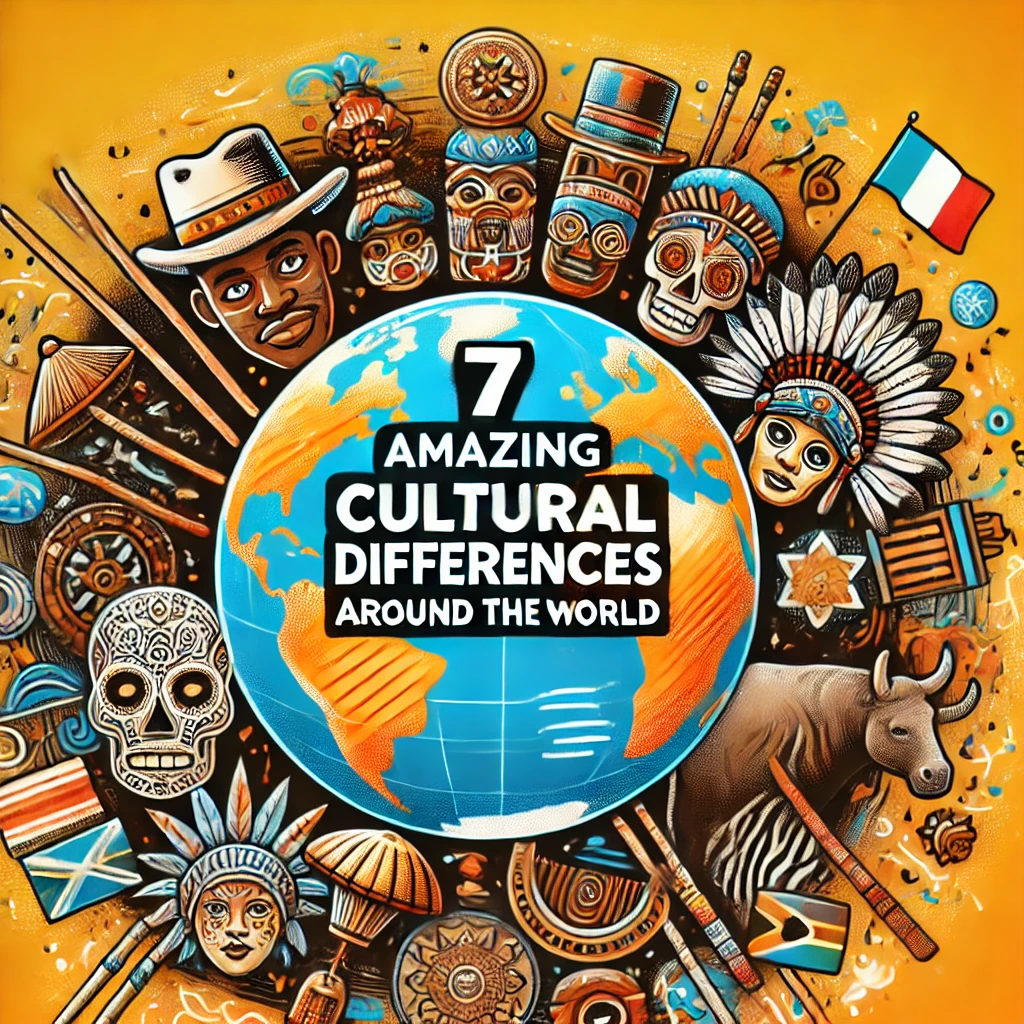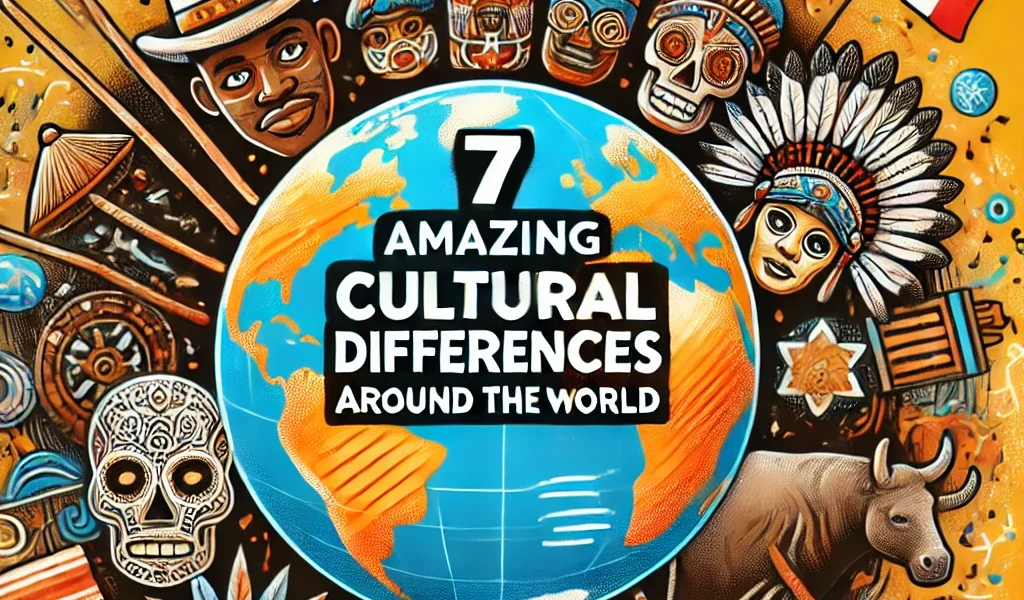Culture shapes how we see the world, how we interact with others, and how we live our daily lives. It influences everything from our manners and food to the way we celebrate and communicate. With so many cultures around the globe, some differences can be quite astonishing, even surprising, for people from other parts of the world. This article will explore seven of the most fascinating cultural differences that highlight the diversity of human experience.

1. Greetings: From Bowing in Japan to Kissing in Europe
One of the most striking cultural differences around the world is how people greet one another. These customs can vary widely, from a simple handshake to more intricate rituals.
Japan: Bowing as a Sign of Respect
In Japan, bowing is a customary way to greet someone and show respect. The depth of the bow indicates the level of respect. A deeper bow shows greater reverence, while a slight nod is used in casual settings.
Europe: Kissing on the Cheek
In many European countries, like France, Spain, and Italy, people greet each other with kisses on the cheek. The number of kisses and which cheek to start with can vary by region. For outsiders, this custom can feel intimate, but it is a standard greeting in these cultures.
Why It Matters:
Greeting customs are deeply rooted in cultural values. Understanding and respecting these differences can prevent misunderstandings and promote smoother cross-cultural interactions.
2. Dining Etiquette: Using Hands in India vs. Utensils in the West
The way people eat and interact with food varies significantly between cultures. Dining etiquette is influenced by centuries of tradition and social norms.
India: Eating with Hands
In India, many people use their hands to eat, especially in the southern regions. It is considered a more personal and respectful way to enjoy food. In Indian culture, the act of touching food with one’s hands is believed to heighten the sensory experience of eating.
Western Countries: Forks and Knives
In contrast, Western cultures typically rely on utensils such as forks, knives, and spoons for eating. Using hands is often reserved for informal meals or specific types of food like burgers or pizza.
Why It Matters:
Dining etiquette can reflect deeper cultural attitudes towards food, hospitality, and community. What might be considered impolite in one culture can be a mark of tradition and respect in another.
3. Personal Space: Close in the Middle East vs. Distant in Northern Europe
How people define personal space can vary dramatically across cultures. While some cultures are comfortable with close proximity, others prefer more distance during interactions.
Middle East: Close Proximity
In many Middle Eastern cultures, close physical proximity is common during conversations, particularly between friends and family members. Personal space is smaller, and it’s not unusual for people to touch or stand close when speaking.
Northern Europe: A Respect for Distance
Conversely, people in Northern European countries like Sweden or Finland prefer more personal space. Standing too close to someone during a conversation can make them feel uncomfortable. The cultural value here is rooted in respecting personal boundaries and autonomy.
Why It Matters:
Understanding cultural norms around personal space can help prevent awkward or uncomfortable situations, especially in international business or travel settings.
4. Time Perception: Punctuality in Germany vs. Flexibility in Latin America
Different cultures have varying attitudes toward time, which can lead to misunderstandings when people from different regions interact.
Germany: Punctuality is Essential
In Germany, being on time is a sign of respect and professionalism. Whether it’s a meeting, a dinner reservation, or public transport, punctuality is taken very seriously, and being even a few minutes late can be seen as impolite.
Latin America: Time is Flexible
In contrast, many Latin American countries have a more relaxed attitude towards time. It’s not uncommon for events to start later than scheduled, and punctuality is not always strictly enforced. Social gatherings often operate on “la hora Latina,” which allows for more flexibility.
Why It Matters:
Time perception is a key aspect of cultural identity. Understanding how different cultures value time can help manage expectations and avoid potential frustrations.
5. Gift Giving: Practicality in China vs. Symbolism in Japan
Gift-giving practices differ across cultures, with variations in how gifts are presented and the meanings behind them.
China: Practical Gifts
In Chinese culture, gifts are often practical and functional. It’s common to give items like food, tea, or household products. However, certain items, such as clocks and sharp objects, should be avoided as they are considered unlucky.
Japan: Symbolic Presentation
In Japan, the presentation of the gift is just as important as the gift itself. Wrapping is meticulous, and how the gift is given reflects the relationship between the giver and the recipient. The act of gift-giving is steeped in symbolism, with great attention paid to the formality of the exchange.
Why It Matters:
Gift-giving customs offer insights into what different cultures value, such as practicality, thoughtfulness, or respect for tradition.
6. Communication Styles: Direct in the United States vs. Indirect in Japan
How people communicate—whether directly or indirectly—varies greatly between cultures, influencing conversations in both personal and professional contexts.
United States: Direct Communication
In the United States, people tend to communicate in a direct manner, valuing transparency and straightforwardness. This style is common in both personal and business interactions, where clarity and assertiveness are often seen as positive traits.
Japan: Indirect Communication
On the other hand, Japanese communication tends to be more indirect and nuanced. Politeness and harmony are prioritized, so people often avoid saying “no” outright or giving direct criticism. Reading between the lines is essential in understanding the true message.
Why It Matters:
Cultural differences in communication can lead to misunderstandings if not properly understood. Awareness of these styles can foster better interactions, particularly in international business settings.
7. Celebrations: Christmas in the West vs. Lunar New Year in East Asia
Different cultures have unique ways of celebrating important holidays, which often reflect their history, religion, and values.
Christmas in the West
In many Western countries, Christmas is the most significant holiday of the year, celebrated with gift-giving, feasts, and decorations. It has religious significance for Christians but has also become a secular celebration of family and togetherness in many parts of the world.
Lunar New Year in East Asia
In East Asian countries like China, Korea, and Vietnam, Lunar New Year is the most important holiday. It marks the start of a new year according to the lunar calendar and is celebrated with family reunions, traditional foods, and cultural rituals. Red envelopes filled with money are given for good luck, and festivities often last for several days.
Why It Matters:
Celebrations provide a glimpse into a culture’s values and traditions. Understanding these differences can deepen your appreciation for diverse ways of marking significant life events.
Conclusion: Embracing Cultural Differences
Cultural differences are what make our world rich and diverse. By understanding and respecting these unique traditions, customs, and behaviors, we can foster greater global understanding and harmony. Whether it’s how people greet each other, communicate, or celebrate, these amazing cultural differences remind us of the beauty in diversity.







